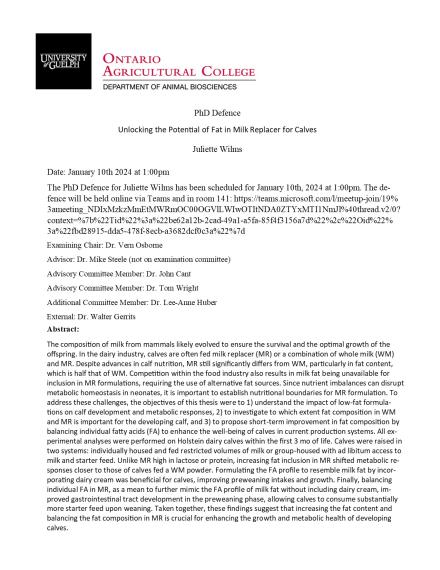Room 141 and Teams: https://teams.microsoft.com/l/meetup-join/19%3ameeting_NDIxMzkzMmEtMWRmOC00OGVlLWIwOTItNDA0ZTYxMTI1NmJl%40thread.v2/0?context=%7b%22Tid%22%3a%22be62a12b-2cad-49a1-a5fa-85f4f3156a7d%22%2c%22Oid%22%3a%22fbd28915-dda5-478f-8ecb-a3682dcf0c3a%22%7d

Unlocking the Potential of Fat in Milk Replacer for Calves
The composition of milk from mammals likely evolved to ensure the survival and the optimal growth of the offspring. In the dairy industry, calves are often fed milk replacer (MR) or a combination of whole milk (WM) and MR. Despite advances in calf nutrition, MR still significantly differs from WM, particularly in fat content, which is half that of WM. Competition within the food industry also results in milk fat being unavailable for inclusion in MR formulations, requiring the use of alternative fat sources. Since nutrient imbalances can disrupt metabolic homeostasis in neonates, it is important to establish nutritional boundaries for MR formulation. To address these challenges, the objectives of this thesis were to 1) understand the impact of low-fat formulations on calf development and metabolic responses, 2) to investigate to which extent fat composition in WM and MR is important for the developing calf, and 3) to propose short-term improvement in fat composition by balancing individual fatty acids (FA) to enhance the well-being of calves in current production systems. All experimental analyses were performed on Holstein dairy calves within the first 3 mo of life. Calves were raised in two systems: individually housed and fed restricted volumes of milk or group-housed with ad libitum access to milk and starter feed. Unlike MR high in lactose or protein, increasing fat inclusion in MR shifted metabolic responses closer to those of calves fed a WM powder. Formulating the FA profile to resemble milk fat by incorporating dairy cream was beneficial for calves, improving preweaning intakes and growth. Finally, balancing individual FA in MR, as a mean to further mimic the FA profile of milk fat without including dairy cream, improved gastrointestinal tract development in the preweaning phase, allowing calves to consume substantially more starter feed upon weaning. Taken together, these findings suggest that increasing the fat content and balancing the fat composition in MR is crucial for enhancing the growth and metabolic health of developing calves.

